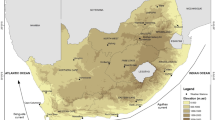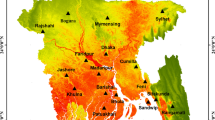Abstract
Extreme temperature is the key indicator of extreme climatic events. The goal of this research was to better understand the long-term trends and shifting behaviors associated with Bangladesh’s record-breaking high temperatures in the country’s atmosphere. Data from 26 Bangladeshi meteorological stations collected between 1981 and 2018 was analyzed with RClimDex. The annual count of warm (cold) spell duration increased, according to the findings (decrease). In the coastal regions, this rising temperature trend is more pronounced. There were longer (shorter) periods of warm (cold) weather in the twentieth century than there were in the previous decade. As a result, the length of warm (cold) spells has become longer since the beginning of the twenty-first century, as compared to the last quarter of the twentieth century. There is little fluctuation in diurnal temperatures, but they are getting smaller and smaller. There is a 13% decrease in the Cold Spell Duration Indicator (CSDI), which indicates that we are in for a long, cold winter. At a rate of 14% per year, the Warm Spell Duration Indicator (WSDI) annual count suggests an extremely hot summer is imminent. Diurnal temperature range (DTR) values decreased by 1.1% year-round, raising the specter of climate extremes like the CSDI and WSD. An increasing (decreasing) trend in indicators of how long hot (cold) weather lasts indicates an increase (decrease) in Bangladesh’s warm atmosphere. As a result, an increase in the number of extreme weather events, particularly along the coasts, should be expected across the country.






Similar content being viewed by others
Data availability
All data and materials supporting the findings of this study are available from the corresponding author on request.
Code availability
All those used in the analysis of this study are available from the corresponding author on request.
References
Abatan AA, Abiodun BJ, Lawal KA, Gutowski WJ Jr (2016) Trends in extreme temperature over Nigeria from percentile-based threshold indices. Int J Climatol 36(6):2527–2540
Abbasnia M, Toros H (2018) Monitoring observed changes in warmdays extremes over Turkey. Nat Resour Conserv Res 2018(1):1–4
Alexander LV et al (2006) Global observed changes in daily climate extremes of temperature and precipitation. J Geophys Res 111:D05109. https://doi.org/10.1029/2005JD006290
Caloiero T (2017) Trend of monthly temperature and daily extreme temperature during 1951–2012 in New Zealand. Theoret Appl Climatol 129(1–2):111–127
Chen D, Walther A, Moberg A, Jones P, Jacobeit J, Lister D (2015) European Trend Atlas of Extreme Temperature and Precipitation Records. Springer, Dordrecht
Donat MG, Alexander LV, Yang H, Durre I, Vose R, Dunn RJH, Kitching S (2013) Updated analyses of temperature and precipitation extreme indices since the beginning of the twentieth century: the HadEX2 dataset. J Geophys Researc: Atmospheres 118(5):2098–2118
Dumitrescu A, Bojariu R, Birsan MV, Marin L, Manea A (2015) Recent climatic changes in Romania from observational data (1961–2013). Theoret Appl Climatol 122(1):111–119
Espírito Santo F, de Lima MIP, Ramos AM, Trigo RM (2014) Trends in seasonal surface air temperature in mainland Portugal, since 1941. Int J Climatol 34(6):1814–1837
Filahi S, Tanarhte M, Mouhir L, El Morhit M, Tramblay Y (2016) Trends in indices of daily temperature and precipitations extremes in Morocco. Theoret Appl Climatol 124(3):959–972
GAIN index summarizes a country’s vulnerability to climate change and other global challenges in combination with readiness to improve resilience. Retrieved March 28, 2020, from https://gain.nd.edu/our-work/country-index/rankings
Hansen JI, Fung I, Lacis A, Rind D, Lebedeff S (1988) Global climate changes as forecast by Goddard Institute for space studies three-dimensional model. J Geophys Res 93:9341–9364. https://doi.org/10.1029/88JD00231
IPCC (2013) Climate change: the physical science basis. The contribution of working group I to the fifth assessment, report of the intergovernmental panel on climate change. Cambridge University Press, Cambridge
Islam AKMR, Ali MH, Amin MGM (2004) Long-term variability of rainfall at different agro-ecological regions of Bangladesh. J Soc Agric Sci Tech 1(1 & 2):19–24
Islam, Moinul (2013) Six or four seasons? Perceptions of climatic changes and people's cooperative attitudes toward flood protection in Bangladesh. IUJ working paper, EMS-2013–06
Karmalkar A, McSweeney C, New M, Lizcano G (2012) UNDP Climate change country profiles: Bangladesh
Kenawy AE, López-Moreno JI, Vicente-Serrano SM (2011) Recent trends in daily temperature extremes over northeastern Spain (1960–2006). Nat Hazard 11(9):2583–2603
Khan MJU, Islam AS, Das MK, Mohammed K, Bala SK, Islam GT (2019) Observed trends in climate extremes over Bangladesh from 1981 to 2010. Clim Res 77(1):45–61
Khan MJU, Islam AKMS, Bala SK et al (2020) Changes in climate extremes over Bangladesh at 1.5 °C, 2 °C, and 4 °C of global warming with high-resolution regional climate modeling. Theor Appl Climatol 140:1451–1466
Kioutsioukis I, Melas D, Zerefos C (2010) Statistical assessment of changes in climate extremes over Greece (1955–2002). Int J Climatol 30(11):1723–1737
Kreft S et al (2017) Global Climate Risk Index 2017. Who suffers most from extreme weather events? Weather-related loss events in 2015 and 1995 to 2015. Retrieved March 28, 2020, from https://germanwatch.org/en/download/16411.pdf
Kruger AC, Sekele SS (2013) Trends in extreme temperature indices in South Africa: 1962–2009. Int J Climatol 33(3):661–676
Kruger AC, Rautenbach H, Mbatha S, Ngwenya S, Makgoale TE (2019) Historical and projected trends in near-surface temperature indices for 22 locations in South Africa. South African J Sci 115(5–6):1–9. https://doi.org/10.17159/sajs.2019/4846
Mearns LO, Katz RW, Schneider SH (1984) Extreme high temperature events: changes in their probabilities with changes in mean temperature. J ClimApplMeteorol 23:1601–1608
Mia NM (2003) Variation of temperature in Bangladesh. Proccedings of SAARC seminar on climatic variability in the South Asian region and its impacts, SAARC Meterol Res Center, pp 94–97
Nemec J, Gruber C, Chimani B, Auer I (2013) Trends in extreme temperature indices in Austria based on a new homogenised dataset. Int J Climatol 33(6):1538–1550
Nishat A, Mukherjee N (2013) Climate change impacts, scenario and vulnerability of Bangladesh, In R. Shaw et al. (eds), Climate Change Adaptation Actions in Bangladesh, © Springer Japan
NOAA (2019) Global climate summary. Retrieved March 28, 2020, from https://www.ncdc.noaa.gov/sotc/global/201913
Popov T, Gnjato S, Trbić G, Ivanišević M (2018) Recent trends in extreme temperature indices in Bosnia and Herzegovina. Carpathian J Earth Environ Sci 13(1):211–224
Rahman MB, Salam R, Islam ARMT, Tasnuva A, Haque U, Shahid S, Hu Z, Mallick J (2021) Appraising the historical and projected spatiotemporal changes in the heat index in Bangladesh. Theoret Appl Climatol 146(1–2):125–138. https://doi.org/10.1007/s00704-021-03705-x
Sheikh MM, Manzoor N, Ashraf J, Adnan M, Collins D, Hameed S, Shrestha ML (2015) Trends in extreme daily rainfall and temperature indices over South Asia. Int J Climatol 35(7):1625–1637
World Bank (2011) Vulnerability, Risk Reduction, and Adaptation to Climate Change: Bangladesh. World Bank Climate Risk and Adaptation Country Profile. Retrieved March 28, 2020, from <https://climateknowledgeportal.worldbank.org/sites/default/files/2018-10/wb_gfdrr_climate_change_country_profile_for_BGD.pdf>
Yu Z, Li X (2015) Recent trends in daily temperature extremes over northeastern China (1960–2011). Quatern Int 380:35–48
Zhang X, Yang F (2004) RClimDex (1.0) user guide. Climate Research Branch Environment Canada, Downsview, Ontario, Canada, pp 47–57
Funding
We greatly acknowledge the Agro-Meteorological Information System Development Project (Component C) BARI Part funded by World Bank & Modelling Climate Change Impact on Agriculture and Developing Mitigation and Adaptation Strategies for Sustaining Agricultural Production in Bangladesh (2nd Phase) Project funded by Krishi Gobeshona Foundation (KGE) for their financial support.
Author information
Authors and Affiliations
Contributions
1 and 2 conceived of the presented idea. 1, 2, and 3 developed the theory and 1 performed the computations. 3, 4, and 5 verified the analytical methods. 4 and 5 encouraged and 2 and 3 supervised the findings of this work. Authors 6 to 15 have collected complied and tabulated all the climatic dataset of different stations. All the authors discussed the results and contributed to the final manuscript.
Corresponding author
Ethics declarations
Ethics approval
-
This material is the authors' own original work, which has not been previously published elsewhere.
-
The paper is not currently being considered for publication elsewhere.
-
The paper reflects the authors' own research and analysis in a truthful and complete manner.
-
The paper properly credits the meaningful contributions of co-authors and co-researchers.
-
The results are appropriately placed in the context of prior and existing research.
-
All sources used are properly disclosed (correct citation). Literally copying of text must be indicated as such by using quotation marks and giving proper reference.
-
All authors have been personally and actively involved in substantial work leading to the paper and will take public responsibility for its content.
Consent to participate
The study uses data from secondary data sources not involving any human subjects.
Consent for publication
The corresponding author gives his consent on behalf of all authors for the publication of identifiable details, which can include photograph(s) and/or videos and/or case history and/or details within the text (“Material”) to be published in the above Journal and Article. I confirm that I have seen and been given the opportunity to read both the Material and the Article (as attached) to be published by the Springer Nature Journal.
I understand that all Springer Nature journals may be available in both print and on the internet and will be available to a broader audience through marketing channels and other third parties. Therefore, anyone can read material published in the journal. I understand that readers may include not only medical professionals and scholarly researchers but also journalists and general members of the public.
Conflict of interest
The authors declare no competing interests.
Additional information
Publisher's note
Springer Nature remains neutral with regard to jurisdictional claims in published maps and institutional affiliations.
Rights and permissions
About this article
Cite this article
Ahmed, I., Ishtiaque, S., Zahan, T. et al. Climate change vulnerability in Bangladesh based on trend analysis of some extreme temperature indices. Theor Appl Climatol 149, 831–842 (2022). https://doi.org/10.1007/s00704-022-04079-4
Received:
Accepted:
Published:
Issue Date:
DOI: https://doi.org/10.1007/s00704-022-04079-4




